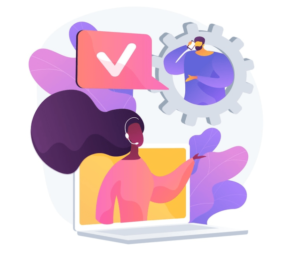The technology of call queuing is central piece to inbound contact centers. When dialing a queuing phone system, customers often receive a welcome message and an IVR menu before being sent to a queue, where they hear hold music and position announcements until an agent becomes available.
In call queues, the typical distribution method is first in, first out. For example, an automated call distributor (ACD) is used in call centers to route incoming calls to certain specialized agents in your contact center. ACDs queue calls until those agents are available.
Call queues simplify callers to obtain telephony services, while ACD queues relieve call center and service workers.
Additionally, there are specific agents whose phones are always plugged into the call queue. Some call queues additionally support dynamic agent connections. During call peaks and high-volume phone calls, extra agents can connect their phones to queues to help other agents and ensure smooth service for callers. As the number of calls in the queue lowers, new agents can detach and return to other activities.
The power of call queue in inbound contact centers
 The technology of call queuing is central piece to inbound contact centers. When dialing a queuing phone system, customers often receive a welcome message and an IVR menu before being sent to a queue, where they hear hold music and position announcements until an agent becomes available.
The technology of call queuing is central piece to inbound contact centers. When dialing a queuing phone system, customers often receive a welcome message and an IVR menu before being sent to a queue, where they hear hold music and position announcements until an agent becomes available.
In call queues, the typical distribution method is first in, first out. For example, an automated call distributor (ACD) is used in call centers to route incoming calls to certain specialized agents in your contact center. ACDs queue calls until those agents are available.
Call queues simplify callers to obtain telephony services, while ACD queues relieve call center and service workers.
Additionally, there are specific agents whose phones are always plugged into the call queue. Some call queues additionally support dynamic agent connections. During call peaks and high-volume phone calls, extra agents can connect their phones to queues to help other agents and ensure smooth service for callers. As the number of calls in the queue lowers, new agents can detach and return to other activities.
What are the technologies your call center needs for call queueing?
Let’s take a look at the some of the key technological components and productivity tools you’ll need to set up your call queueing system:
Interactive Voice Response system (IVR) for call centers
Automatic Call Distribution System
An ACD or automatic call distribution system effectively routes calls to the agents who are active, available, and best equipped to handle them.
ACD is the primary characteristic that separates a telephone system from a switchboard, which lacks this functionality and call center software, which requires a dynamic and efficient automated call distribution system to manage a large volume of calls with limited resources.
Advantages of call queue for inbound contact centers
Currently, one of the primary problems of many businesses is how to manage their client relationships. This is because contact centers now understand that poor customer service and low customer experience has a direct impact on their profits, both positively and negatively.
Here are some of the advantages of improved customer service provided by a call queueing system:
- Customers grow more loyal and more engaged to company.
- Customers feel less stressed in a well-organized queue because they have less to worry about.
- The list of new customers grows as a result of the customers’ positive referrals.
- Lower investment required to recoup lost consumers.
- Better customer complaint and claim handling.
1. Flexibility
2. Easier to Use
Since a call queue system does not require any human interaction, you will save time on administrative tasks like ticket bookings, waitlist, etc.

